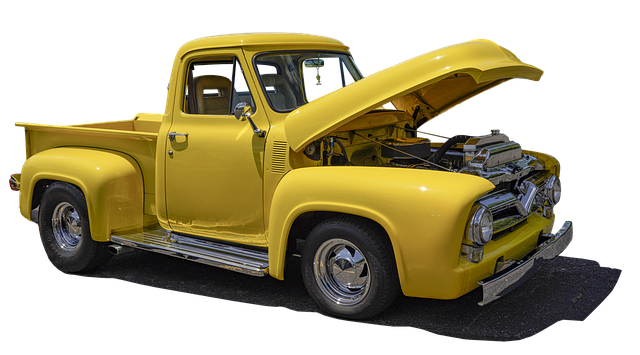Looking to register your car in California? This comprehensive guide walks you through the step-by-step process, ensuring a smooth experience. From understanding eligibility requirements to gathering essential documents, this article covers it all. Learn why verifying your vehicle’s identity using a DMV VIN verifier is crucial and how to complete registration effortlessly. By following these simple steps, you’ll be cruising down California roads in no time.
- Understand Eligibility Requirements for Car Registration
- Gather Necessary Documents for Car Registration
- Visit Your Local DMV Office or Use Online Services
- Verify Vehicle Identity Using VIN (Vehicle Identification Number)
- Complete Car Registration and Pay Associated Fees
Understand Eligibility Requirements for Car Registration

Before you start the registration process, it’s crucial to understand the eligibility requirements set by the California Department of Motor Vehicles (DMV). To register your car, your vehicle must meet certain criteria. One key step is ensuring that your car has a valid and accurate Vehicle Identification Number (VIN) verifier. The DMV uses this unique 17-character identifier to verify the vehicle’s make, model, year, and other critical details. Using a reliable mobile VIN verifier can streamline this process, as it allows you to quickly and easily access important data associated with your car’s VIN.
Additionally, your vehicle must be in good working condition and meet safety standards set by the DMV. This includes passing an emissions test (if applicable) and ensuring all necessary documents are in order. A mobile VIN inspection can help you catch any potential issues early on, as it provides a comprehensive check of your car’s history and condition. By adhering to these requirements, you’ll be well on your way to successfully registering your vehicle with the California DMV.
Gather Necessary Documents for Car Registration

Before heading to the DMV, make sure you have all the required documents for car registration. The California Department of Motor Vehicles (DMV) requires a variety of information to process your registration, and having these documents ready can streamline the process. One crucial document is the Vehicle Identification Number (VIN) verifier, which ensures that the vehicle’s details match those on record. You can obtain this through a mobile VIN verification service or by visiting an authorized inspection station for a physical inspection.
Additionally, you’ll need proof of ownership, typically in the form of a title document; valid identification, such as a driver’s license or state-issued ID; and payment for registration fees. If you’ve recently purchased the vehicle, you might require additional paperwork from the seller to prove the transfer of ownership. Ensuring that all these documents are readily available can save you time during the registration process at the DMV.
Visit Your Local DMV Office or Use Online Services

Whether you’re new to California or just buying a car for the first time, registering your vehicle is a necessary step. You can complete this process in-person at your local DMV (Department of Motor Vehicles) office or leverage online services, offering convenience and efficiency. If you opt for an in-person visit, be prepared with essential documents such as proof of identity, vehicle ownership, and insurance. The DMV staff will guide you through the registration process, which includes verifying the Vehicle Identification Number (VIN) to ensure the car’s history is clear and meets California’s safety standards.
For a smoother experience, consider utilizing online services or mobile VIN inspection tools. These platforms allow you to initiate the registration process from the comfort of your home by inputting your VIN to access detailed vehicle history reports. This initial step can save time and help identify any potential issues early on. Whether you choose traditional or digital methods, ensuring your car is registered correctly is crucial for roadworthiness and legal compliance in California.
Verify Vehicle Identity Using VIN (Vehicle Identification Number)

Before registering your car in California, it’s crucial to ensure the vehicle’s identity is verified accurately. One effective way to do this is by using the Vehicle Identification Number (VIN). Every vehicle has a unique VIN, serving as a digital fingerprint that can reveal important details about the car, including its make, model, year, and even history of ownership. You can easily verify the VIN through a dmv vin verifier or even with a mobile vin verification app.
Simply enter your VIN into these tools to gain instant access to detailed information. Some even offer an on-site mobile vin inspection, allowing you to cross-check the data against the vehicle itself, ensuring it matches up and is free from any discrepancies. This step is essential in preventing fraud and ensuring that you’re registering a legitimate vehicle with accurate documentation.
Complete Car Registration and Pay Associated Fees

After gathering all necessary documents, it’s time to complete your car registration process with a trip to the DMV. Bring your vehicle’s registration application, proof of insurance, and a valid driver’s license. An important step before submitting is to use a DMV VIN verifier to ensure your vehicle’s identification number (VIN) is accurate and matches the details in the documents you’re providing. This helps streamline the process as any discrepancies can cause delays.
To pay associated fees, you typically have several options including cash, credit card, or debit card. Be prepared with the exact amount required for registration and any additional fees that may apply based on your vehicle’s type, age, and use. Some counties in California offer the option of mobile vin inspection or a mobile vin verifier, allowing for even greater convenience during this process.
Registering a car in California is a straightforward process that requires understanding eligibility criteria, gathering essential documents, and completing a few key steps. By verifying your vehicle’s identity using its unique VIN (via a dmv vin verifier), you ensure accuracy and compliance. Whether visiting a local DMV office or utilizing online services, the process is designed to be efficient. Once completed, you’ll have officially registered your vehicle, adhering to California’s regulations.
